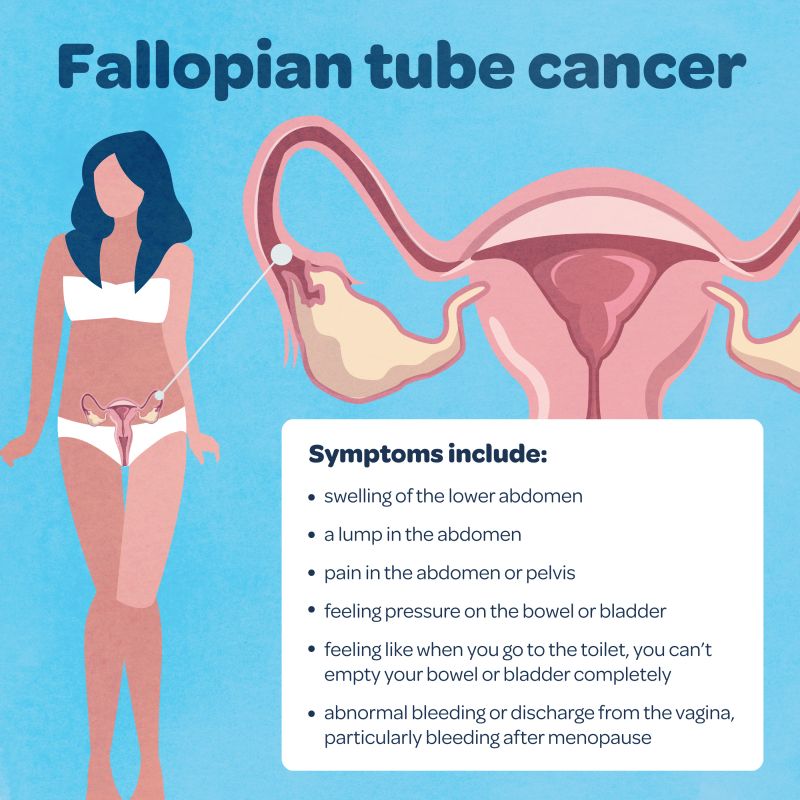Table of Contents
Fallopian tube cancer, also called tubal cancer, is a rare form of malignant tumor. It occurs when a group of cells in the fallopian tube grow with the normal tissue in the tube. If left untreated, the cancer can spread into your lower abdomen (pelvis) and stomach areas creating fallopian tube cancer.
The fallopian tubes are two narrow ducts that extend from the ovaries to the uterus, measuring 10-14 cm long and 3-8 millimeters in diameter. They play an important role in the female genital tract. At each ovulation, the ovary releases one egg. That egg is captured by the infundibulum of the fallopian tube and is transported to the uterus by a group of hair-like structures (cilia) that form the tubal mucosa. If fertilization occurs, the embryo formed is propelled by the cilia in the uterine cavity.
Fallopian Tube Cancer Statistics
Cancer of the fallopian tubes is the rarest of gynecologic cancers, representing approximately 1-2% of all gynecological cancers worldwide. In the United States, the incidence of fallopian tube cancer was estimated at 0.41 per 100,000 women from 1998 to 2003. The highest incidence was found in white, non-Hispanic women and women aged 60–79.
Fallopian Tube Cancer Causes
Fallopian tube cancer occurs when there is abnormal cell proliferation in the fallopian tube. These cells were initially normal; however, due to certain pathogenic factors, they have acquired characteristics that allow them to divide indefinitely to form a malignant growth. In the early stage of the cancer, the cancer cells are confined inside the tube. Over time, some cells can migrate from their original place and form new tumors in other tissues or organs (metastatic fallopian tube cancer).
However, it is very rare that the cancer develops directly in the fallopian tubes. In most cases, fallopian tube cancer is a metastasis; the cancer comes from another malignant tumor that started elsewhere in the body, mainly the ovaries, endometrium, GI tract, peritoneum, or the breasts.
Fallopian Tube Cancer Risk Factors
Risk factors of fallopian tube cancer are not well known. However, sex, age, race, pelvic inflammatory disease, and certain chronic diseases such as TB are etiological factors suspected in the development of the tumor. In addition, fallopian cancer is sometimes found in patients that have a history of infertility. Other risk factors include:
- Age – Cancer of the fallopian tubes is rare; it affects mostly women aged 60-79.
- Race – The highest incidence of fallopian tube cancer is found in white, non-Hispanic women.
- Menopause – Although fallopian tube cancer can affect younger women, it is more common among post menopausal women.
- Personal / family history – A factor in the development of fallopian tube cancer is a history of ovarian cancer in your immediate family; this risk is even higher if you have a personal history of cancer in the ovary (ovarian cancer).
- Genetic –Several new studies have shown that the mutation in a human gene called BRCA1 can be associated with a significant increase in the risk of breast cancer, as well as, fallopian tube cancer.
Fallopian Tube Cancer Symptoms
 You can have fallopian tube cancer for a long period without experiencing any symptoms. When symptoms finally emerge, they may be taken for those of other medical conditions.
You can have fallopian tube cancer for a long period without experiencing any symptoms. When symptoms finally emerge, they may be taken for those of other medical conditions.
In general, if you have fallopian tube cancer, you can experience:
- presence of pelvic mass or lump
- sensation of pressure in the abdomen
- white, clear, or pinkish vaginal discharge
- general malaise
- abdominal pain
- bleeding after menopause
Fallopian Tube Cancer Complications
The fact that cancer can remain asymptomatic for years means the tumor can grow significantly in volume or spread to other tissues before it is diagnosed. It can spread by direct extension or through the lymphatic circulation to form metastasis in other organs such as the pelvis and stomach.
If you experience symptoms related to fallopian cancer, consult your doctor immediately. However, although these symptoms can indicate they disease, they do not necessarily mean that you have fallopian cancer.
Fallopian Tube Cancer Diagnosis
Symptoms of fallopian tube cancer do not manifest at the beginning of the disease. In addition, because of the proximity of the uterus and ovary, the diagnosis is very difficult to confirm by a simple pelvic exam. Specific exams are needed along with the pelvic exam.
Pelvic Examination – Your physician will ask you questions about the symptoms you experience and perform a pelvic exam to examine your uterus, vagina, ovaries, fallopian tubes, bladder, and rectum.
Your doctor can also perform a Pap test and imaging techniques to rule out the presence of ovarian or uterus cancer. Those cancers often present symptoms similar to those of the Fallopian tube. Other tests that can be done to confirm the cancer are CA 125 blood test, gynecologic ultrasound, CT scan, MRI of the pelvis, and a biopsy.
CA 125 blood test – Your doctor may take sample of your blood to perform a CA 125 blood test. CA 125 is a protein, which is considered as a tumor marker; it is often elevated in women with ovarian cancer. Most of the time, this testing is recommended in the fallopian tube cancer diagnosis to rule out other gynecological cancers.
Gynecologic Ultrasound – This painless, noninvasive, and safe diagnostic technique allows your physician to examine your uterus, ovaries, fallopian tubes, and bladder. If you experience pelvic or abdominal pain, irregular bleeding and/or heavy menstrual bleeding, you will likely be recommended a gynecologic ultrasound. Your physician may also recommend this test if pelvic or abdominal abnormalities have been found during the physical exam.
CT scan – A CT-scan is a medical technique involving the use of a special x-ray machine with sophisticated computers that can create three-dimensional picture of the tissues of your body. Excessive use of CT scans can lead to health problems. The magnetic resonance imaging (MRI) is non-radiating and may represent an alternative for some applications of CT scan, but cannot replace the CT imaging.
MRI of the pelvis – This medical technique consists of applying a combination of electromagnetic waves at high frequency on your pelvis to produce detailed images. After injecting a contrast medium (or contrast agent) into your vein, this technique allows your health care provider to determine the chemical composition and the nature of biological tissues of your fallopian tube and detect the presence of abnormalities such as malignant tumor.
Biopsy – To confirm accurately the presence of cancerous cells in your fallopian tube, your doctor will recommend a biopsy. In general, a pathologist will remove a small amount of tissue from the fallopian tube for laboratory analysis. The result will be interpreted by your doctor or a physician specialized in interpreting and diagnosing the changes caused by disease in tissues and body fluids.
Fallopian Tube Cancer Stages
Once the presence of the cancer is confirmed, your physician will determine its stage. Determining the stage of the cancer helps him to choose the treatment most appropriate and effective to fight the tumor. In general, the stage of fallopian tube cancer is determined by the size of the tumor and degree of the cells spreading within your body.
The fallopian tube cancer stages include:
- Carcinoma in situ – The cancer is limited to the tubal mucosa.
- Stage I – At this early stage, the cancer is limited to the fallopian tubes.
- Stage II – At this stage, the cancer has reached one or both fallopian tubes, and has spread to the pelvis.
- Stage III – At Stage III, the cancer has affected one or both fallopian tubes, and has spread outside the pelvis.
- Stage IV – The cancer has reached one or both fallopian tubes, is outside the pelvis, and has spread to distant organs such pleura, peripheral lymph nodes, lungs or/and skin.
- Recurrent – A fallopian tube cancer that has returned after treatment is considered a recurrent cancer. In general, recurrent cancers are more difficult to be treated and the survival chance is lower.
Fallopian Tube Cancer Treatment
Fallopian tube cancer treatment depends on the extent and stage of the cancer and the presence or absence of metastases. Your doctor can also consider your general health and age to recommend you an appropriate therapy. Knowing these details, your oncologist can determine which treatment is most effective for your cancer. After envisaging a treatment, you will be invited to participate in the final choice.
Most of the time, the treatment of fallopian tube cancer includes surgery, chemotherapy, and radiotherapy. If the cancer is diagnosed early, your health care provider can use surgery or a combination with radiotherapy to treat it. In case of an advanced cancer, the treatment will include chemotherapy.
Surgical treatment
Surgical intervention is often performed to treat tubal cancer. The type of surgery performed depends on the extension of the cancer and its location. Fallopian tube cancer tends to spread to the uterus and ovary; your surgery can perform a total abdominal hysterectomy in order to remove the ovaries, tubes, and the uterus along with the cervix.
If the cancer is aggressive or has spread to other organs and cannot be completely removed, a cytoreduction surgery combined with chemotherapy can be necessary. The goal of this therapy is to decrease the size of the tumor for subsequent treatments.
Chemotherapy
Chemotherapy is the use of powerful drugs to destroy cancer cells or prevent them from growing. Unlike surgery and radiotherapy, chemotherapy attack cells in your entire body. Most often, treatment consists of simultaneous administration of several chemotherapeutic agents (polychemotherapy).
Whatever agents and dosage administered, the drugs must be strong enough to destroy the cancer cells but not so powerful that it destroys too many healthy cells. In most cases, the chemotherapy drugs will be given by intravenous injection approximately five times a week over a period of three months.
The chemotherapy drugs always cause side effects. The most common include:
- nausea and vomiting
- loss of appetite
- loss of hair loss
- anemia
- bleeding
- fatigue
- low sex desire
- menstrual irregularity
- increased risk of infections
Radiotherapy (Radiation therapy)
Radiotherapy is a cancer treatment consisting of using x rays to destroy cancer cells by preventing them from dividing. Unlike chemotherapy, radiation acts locally on the treated area. For women who have an advanced fallopian tube cancer, radiation may be used to shrink the tumor and make it possible to be removed surgically. Radiation therapy can also be used to relieve pain caused by a cancer that has spread into other parts of the body.
The three most common side effects of radiotherapy include:
- fatigue
- nausea and vomiting
- skin redness and pain
Fallopian Tube Cancer Survival Rates
Fallopian tube cancer prognosis depends greatly on the stage of the tumor when it is diagnosed. Your lifestyle during and after the treatment also play an important role in your chance to survive.
If you were diagnosed with stage 0 or 1 fallopian tube cancer, your five-year survival rate can be up to 91%. In an advanced cancer, however, your five-year survival rate drops considerably. In 1991, it was reported that about 50% of patients with advanced stage fallopian tube cancer that underwent a surgical approach followed by cisplatinum-based chemotherapy survived 5 years.
Fallopian Tube Cancer Prevention
The best way to prevent the onset of cancer is to live a healthy lifestyle. Your lifestyle and environment often open the door to many cancers including fallopian tube cancer. Even if you are at low risk, you might have cancer if you continue to expose yourself to carcinogens.




